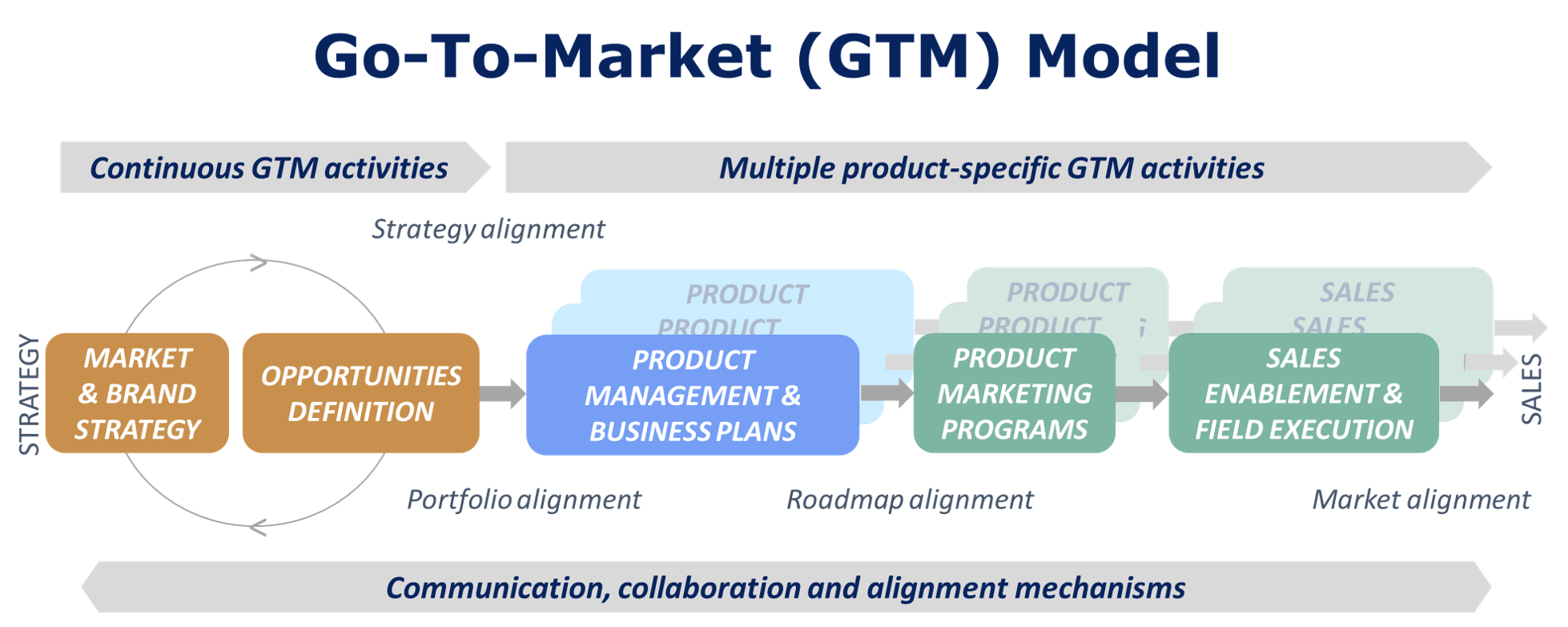Why is our go-to-market so inefficient and slow?
How to speed up the process of getting from strategy to sales is, for most organizations, a complicated process that gets harder the larger they become. The complexity derives from requiring collaboration and efficient hand-offs across functional and operational reporting lines. Based on our experience, we have identified 6 factors that can dramatically improve the speed and performance of your go-to-market approach.
By Stephen Redwood and Colin Taylor
QUICK READ
Cross-functional synchronization and alignment around a unified go-to-market approach is uncommon but has great value. Transforming your go-to-market approach can increase brand value, optimize growth investments, empower sales teams and accelerate time-to-revenue. This article discusses six tips to realizing this latent value in your organization:
- Minimize your limiters (decision making and hand-off hold-ups) and maximize your accelerators (streamlined processes, formal collaboration mechanisms, clear accountabilities)
- Build a single company-wide model to establish a trusted and consensus view of all the interlocked go-to-market activities working together
- Clarify accountabilities and devolve decision making closer to hand-offs across the business system
- Build a company-wide, shared sense of accountability into processes and KPIs. Establish cross business communities that bring together critical silos at the intersections of hand-offs
- Adjust goals, provide training, communicate continuously, and keep leaders on point
- Establish oversight mechanisms to ensure the system is continuously updated to keep it relevant
MORE DEPTH
How a company gets from strategy to selling products, solutions and services in their market is a reflection of how well they function as an organization. Why? Because, rather like the operation of a car in getting from point A to point B, the number of moving parts working seamlessly together is integral to the smoothness and efficiency of the ride. It’s an intricate combination of specialized components and systems, all designed to work together in perfect synchronization. As product cycles increase in frequency and development roadmaps become more complex, businesses must tune-up their go-to-market operations to work in harmony.
But when it comes to strategic alignment between corporate strategy and business unit execution, many organizations experience a recurrent misfire; or worse, the engine is simply not connected to the transmission. This causes lost revenue, delays and confusion as strategic and operational resources struggle to agree, optimize and synchronize growth opportunities.
An effective go-to-market (GTM) system requires, at the very least, organizational alignment and a model that explains how it will operate. What, then, does a GTM model include? At its simplest it is a unified description of the work activities (and who performs them) required to take products, solutions and services from concept to revenue, enabling a company to address its markets effectively through an optimized portfolio of growth opportunities. The GTM model also brings focus and clarity to how the business system operates through:
- The functional capabilities required to deliver the company strategy
- Describing how work should get done across all stages of the model
- Defining point accountabilities and levels of responsibilities
- Providing clarity about what is expected of every role involved in getting products, solutions and services to market
Every company has its own ways of getting to market, but our experience shows that few have maximized the potential for speeding time-to-market or, more importantly, time-to-revenue. That requires looking across all the contributing elements and thinking of them as one system – complex maybe, but a single system nevertheless. In particular, we have found the following 6 themes to be consistently overlooked, in part or as a whole, despite their critical impact on the ability to gain a strong position in chosen markets.
The Need for Speed
We all know that cycle times are getting faster in every aspect of business. But optimizing the cycle times of individual GTM process elements, does not optimize the whole system. Why not? Because, in a business, the hand-offs between functions and the decision-making processes all too often operate as limiters, or brakes, on momentum. For example, agile product development does not speed time-to-market without integrated and seamless hand-offs across strategy, market intelligence, product management, product marketing and sales.
A key goal of GTM transformation is to accelerate time-to-revenue – from strategy to concept to sales. To optimize and speed up processes, GTM limiters (decision making and hand-off hold-ups) need to be minimized and the impact of accelerators (streamlined processes, formal collaboration mechanisms, clear accountabilities) needs to be increased.
To accelerate revenues, GTM must embed proactive methods to ensure a smooth and progressive drive to market. Let’s consider sales and distribution – execution occurs late in GTM, but developing distribution strategies for products and services must begin very early on (during growth portfolio decision-making) to ensure correct priorities and prevent hand-off delays to sales teams, channels or partners. Similarly, cross-functional collaboration with clear accountabilities are essential to fully informing, aiming and empowering sales teams and channel partners to sell.
Gaining GTM speed is not getting any easier. Consider how a transition to managed services is impacting many traditional product companies. Customers want flawless service delivery with turn on / turn off payment terms. This introduces new decision-making and hand-offs that can only be solved through collaboration with clear accountabilities in areas such as pricing, service quality and sales channels. Company-wide GTM clarity is essential to successfully achieving this kind of transition in the marketplace.
Minimize your limiters (decision making and hand-off hold-ups) and maximize your accelerators (streamlined processes, formal collaboration mechanisms, clear accountabilities).
Shift perspective by 90 degrees
All the component parts of a GTM model make for a complex system, and complex systems have certain properties that affect how they operate. Among them: non-linearity, emergence, adaptation, and feedback loops. The classic organizational response to complexity (and one contributing reason to why your speed-to-market may be so slow) is to divide things into groupings like functional departments where vertical reporting relationships dominate. However, to get a product or service from strategic decision to meeting revenue plan in the market requires a different approach.
By turning the organization 90 degrees and seeing it as a network of horizontal relationships that work together (like the car engine) on progressive tasks enables collaboration across boundaries. It makes sense – a compelling value proposition needs industry intelligence, market segmentation, customer validation, product differentiators, buyer personas, some degree of industry buzz and, ultimately, sales training before customers can even think about inking deals. Consequently, effective cross-functional collaboration is imperative to delivering compelling solutions to customers that have appetites to buy. Only then will you win in the market and meet your company’s growth goals.
From a practical point of view, this means the start point should be a model that articulates the flow of processes and activities that takes us from start (strategy) to end (selling) and back again (feedback). Once you then overlay it with your organizational groupings (for example marketing, product management, business development and sales), the critical importance of collaboration for success will be clear. Here is what it looks like at 30,000 feet:

Build a single company-wide model to establish a trusted consensus of all the interlocked go-to-market activities working together.
Devolve centralization
This may seem like an oxymoron but, really, it’s not (stick with us). The point here is that a horizontal view of the organization shows how hand-offs need to work across functional boundaries. This quickly gets one into the details of exactly what needs to be done at each stage and who needs to be involved. The centralization component is reflective of the reality that specialist skills are involved at each stage: strategy, marketing, product management, product marketing and sales.
Even though each stage of the GTM model will involve different skill sets working together, accountabilities still need to be defined and centered in one place – this is the A of the RACI model. Marketing cannot develop buyer personas without input from sales; product roadmaps need input from developers, the field, marketing and strategy; and product portfolios need input from a myriad of sources for strategy to map and optimize company growth priorities.
Accountabilities and responsibilities for scores of go-to-market tasks need to be devolved deep enough into the structure to enable horizontal hand-offs without the delays inherent in passing things between functional hierarchies. In a complex system this will avoid a collaborative free-for-all.
Clarify accountabilities and devolve decision making closer to hand-offs across the business system.
“Marketing is too important to be left to the marketing department.”
David Packard, the co-founder of Hewlett-Packard, said those words a few decades ago and while the statement raises eyebrows, the thinking behind it is still valid.
One of our clients recently observed that the risk of transforming to an integrated GTM model is that everyone looks for a single accountable individual for GTM, and that individual is likely the head of marketing. Between corporate marketing and product marketing, there isn’t much across the GTM journey that isn’t influenced by what marketing does, but that does not mean marketing is accountable for every GTM activity.
While there are some critical dependencies, to say marketing owns GTM is like saying that the head of marketing at your favorite car manufacturer was responsible for the success of a particular model. Clearly, strategy, design, engineering, manufacturing, supply chain and sales, among others, play a critical role. The key to a successful GTM model is to build a sense of shared accountability that is designed into the way things are done (processes, KPIs, cross-business communities) and overseen by a senior executive with a broad enough portfolio to be credible across the continuum of what is needed.
Build a company-wide, shared sense of accountability into GTM processes and KPIs. Establish cross business communities that bring together critical silos at the intersections of hand-offs.
“Culture eats strategy for breakfast”
When the management guru, Peter Drucker, said this he was referring to the importance of the norms and values of an organization and the strength of their influence over how individuals behave. For most companies, introducing a new set of GTM behaviors is, like all change, an enormous challenge because existing habits and incentives are likely strongly embedded and not aligned with where you are trying to get to. This is where we have found that the critical role of HR leadership can make or break the success of GTM transformation.
Changing behaviors takes more than a few new KPIs and bonus structures, it requires clear communications about the goals, what is needed, how it will get done and the support that will be provided. It requires training to explain the GTM system, how it will operate and answer questions of those who will be impacted. It requires leaders to stay on point and provide constant reinforcement of new and collaborative ways of working outside their conventional silos.
As Ann Menard, Global Head of HR at Spirent Communications, said to us recently, “Everyone talks about change being a constant but, in reality, it is the pressure to change that is constant. For us, it was clear that gaining acceptance of a company-wide go-to-market model required, above all, a clear and specific articulation of the goals and required outcomes, along with expectations about the new ways of working that would get us there.”
The amount of effort required to manage change to a new, unified GTM system will depend on your starting point. In particular, the degree to which your business unit and functional leaders are already aligning with corporate strategy will govern the speed of adoption. To illustrate this, consider two ends of an industry spectrum – Apple compared to a conglomerate.
Apple’s loyal user base pays premium prices and expects a consistent customer experience for products and services whether purchased directly from Apple or through ecosystems that Apple controls, such as the App Store. This unwavering focus on customer experience is a strategy that is ingrained culturally in all parts of the organization.
Gaining rapid adoption rates for a new GTM system in organizations at the Apple end of the spectrum is far less grueling than for organizations with siloed, autonomous business units because the culture is more receptive to company-wide alignment for greater wins.
Adjust goals, provide training, communicate continuously, and keep leaders on point.
“The road to success is always under construction”
Lilly Tomlin, actress and comedian, was probably not thinking of a GTM model when she said this, but the quote is still very apt: the road to market is a dynamic ever-changing path. Each part of the model is subject to shifting variables: markets evolve, products develop or decline, channels change, customer needs mature and new ones arise. In the midst of all these shifting variables, a consistent framework in the form of a GTM model provides a structure where disorder may have existed, helping to ensure that nothing falls between the cracks.
Product-specific activities within GTM cater for a range of customer personas, value propositions, product plans, marketing programs, sales channels and other characteristics. These are often unique to one particular product or business unit, but the actual work descriptions, accountabilities and responsibilities are consistent across all solutions, products and services.
It requires effort and collaboration to ensure the GTM model remains relevant and helpful for all situations across your company’s growth portfolio: GTM activities and processes will need updating, plans will change, responsibilities and KPIs need resetting. Just as an orchestra requires a conductor to ensure all the musicians have the right musical scores and are working together effectively, so too does GTM need its own oversight and governance to keep it on track.
Establishing a GTM governance structure and cadence is essential to ensuring the model maintains currency and is updated regularly to provide guidance to all the moving parts. Other critical success factors include ensuring sufficient training, access to GTM resources and identification of functional GTM experts to provide local GTM advice to their teammates. These experts also watch out for GTM improvement opportunities and update needs to feed through the governance community.
Establish oversight mechanisms to ensure the system is continuously updated to keep it relevant.
In summary, increasing go-to-market efficiency, agility and speed is central to your optimization of revenue growth. Tuning-up your organization to a common, company-wide GTM model is essential to achieving this goal and beating your competition to win the key customers you seek.
If you are focusing on strengthening your Go-To-Market system, let’s chat. With our diagnostic tool we can quickly provide you with insights into where you should be focusing attention in order to optimize your growth portfolio and speed your time-to-market and revenue.
Redwood Advisory Partners has decades of experience supporting clients through the design and implementation of organizational transformations, including cross-business systems like GTM. Follow or connect with the founder, Stephen Redwood, on LinkedIn (where you can find other articles in this series) or visit www.redwoodadvisorypartners.com. You can contact Stephen directly by email at [email protected]
Colin Taylor is the principal at Cleaca Consulting LLC and specializes in marketing and business development to help clients identify, define, develop and implement strategic growth initiatives such as GTM transformation. Connect with Colin on LinkedIn, visit www.cleaca.com, or email him at [email protected].





Leave a Reply